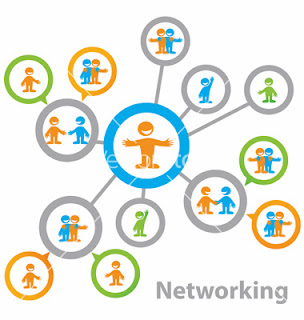What is Computer
network?
A
computer network or data network is a telecommunications network that
allows computers to exchange data. In computer networks, networked computing
devices pass data to each other along data connections. The connections ( network link ) between nodes are established using either cable
media or wireless. The best-known
computer network is the internet.
Network
computer devices that originate, route and terminate the data are called network nodes. Nodes can include hosts
such as servers and personal computers, as well as networking hardware. Two devices are
said to be networked when a device is able to exchange information with another
device.
Computer
networks support applications such as access to
the World Wide Web, shared
use of application and storage servers, printers, and fax machines, and use of email and instant
messaging
applications. Computer networks differ in the physical media used to transmit
their signals, the communications protocols to organize network
traffic, the network's size, topology and organizational
intent.
Network topology
The
physical layout of a network is usually somewhat less important than the
topology by which network nodes are connected. Most diagrams that are drawn to
describe a physical network are therefore topological, rather than geographic.
The symbols on these diagrams usually denote network links and network nodes.
Network links
The
communication media used to link devices to form a computer network include electrical cable ( HomePNA, power line communication ), optical fiber ( fiber-optic communication ), and radio
waves (wireless networking).
A
widely adopted family of
communication media used in local area network (LAN) technology is
collectively known as Ethernet. Wireless LAN standards use radio
waves,
or others use infrared signals as a
transmission medium. Power line communication uses
a building's power cabling to transmit data.
Wired technologies
The
orders of the following wired technologies are, roughly, from slowest to fastest transmission speed.
Twisted pair wire is the most widely used medium for all
telecommunication. Twisted-pair cabling consist of copper wires that are
twisted into pairs
Coaxial cable is widely used for
cable television systems, office buildings, and other work-sites for local area
networks. The cables consist of copper or aluminum wire surrounded by an
insulating layer (typically a flexible material with a high dielectric
constant), which itself is surrounded by a conductive layer. The insulation
helps minimize interference and distortion. Transmission speed ranges from 200
million bits per second to more than 500million bits per second.
An optical fiber
is
a glass fiber. It uses pulses of light to transmit data. Some advantages of
optical fibers over metal wires are less transmission loss, immunity from
electromagnetic radiation, and very fast transmission speeds of up to trillions
of bits per second. One can use different colors of lights to increase the
number of messages being sent over a fiber optic cable.
Wireless technologies
Terrestrial microwave – Terrestrial microwave
communication uses Earth-based transmitters and receivers resembling satellite
dishes. Terrestrial microwaves are in the low-gigahertz range, which limits all
communications to line-of-sight. Relay stations are spaced approximately
48 km (30 mi) apart.
Communications satellites – Satellites communicate via
microwave radio waves, which are not deflected by the Earth's atmosphere. The
satellites are stationed in space, typically in geosynchronous orbit
35,400 km (22,000 mi) above the equator. These Earth-orbiting systems
are capable of receiving and relaying voice, data, and TV signals.
Radio and spread spectrum
technologies –
Wireless local area networks use a high-frequency radio technology similar to
digital cellular and a low-frequency radio technology. Wireless LANs use spread
spectrum technology to enable communication between multiple devices in a
limited area. This wireless radio-wave technology known as Wifi.
Modems (MOdulator-DEModulator)
are used to connect network nodes via wire not originally designed for digital
network traffic, or for wireless. To do this one or more frequencies are
modulated by the digital signal to produce an analog signal that can be
tailored to give the required properties for transmission.
Repeaters
A
repeater is an electronic device that receives
a network signal, cleans it of unnecessary noise, and
regenerates it. The signal is retransmitted at a higher power
level, or to the other side of an obstruction, so that the signal can cover
longer distances without degradation.

Routers
A typical home or small office router showing the ADSL telephone line and Ethernet network
cable connections. A router is
an internetworking device that forwards packets between networks by
processing the routing information included in the packet or datagram. The
routing information is often processed in conjunction with the routing table. A
router uses its routing table to determine where to forward packets.










